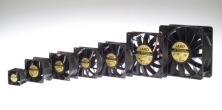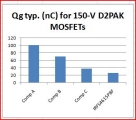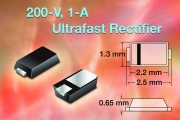HOW2POWER TODAY |
 |
|
ISSUE: September 2009 | |
To ensure receipt of your newsletter, please add david@how2power.com to your address book. | |
 |
IN THIS ISSUE:From the Editor’s Desk Switching-Regulator Insights: Achieving Longer
Battery
Life in DSP Systems A Simpler Way to Dim Fluorescent Lamps Frequency Dithering: A Tool for Overcoming
Last-Minute EMC Hurdles New Power Products Power Supply Jobs & Technology Kudos2
From the Editor's Desk David G. Morrison
Editor, How2Power TODAY
 Welcome to the very first issue of How2Power Today, an e-mail newsletter that addresses design challenges in power conversion and power management. When you open your copy of this newsletter each month, expect to find practical power design articles on timely topics. Many of these articles have an application focus, presenting design techniques and solutions that can be immediately applied in the real world. Also, expect to find probing stories about new power products. Going beyond the press release, these stories provide facts, graphics, and perspective you won’t find in other publications. And discrete components that get minimal attention elsewhere—passives, magnetics, thermal management devices, interconnects, and semiconductors—will get their due here. Finally, you’ll find news and commentary on the power electronics jobs scene to help you stay current with changes in the profession that could affect you. Not your run-of-the-mill newsletter, but one I hope you’ll look forward to reading. |
|

HOW2POWER EXCLUSIVE DESIGN ARTICLES 
|

Switching-Regulator Insights: Achieving Longer Battery
Life in DSP Systemsby Sridhar Gurram, Oliver Brennan,
and Tim Wilkerson, Analog Devices Battery-powered systems such as MP3 players typically employ an embedded digital signal processor (DSP) to achieve maximum processing power when handling multimedia applications. Battery life is of prime importance in these products, so the efficiency of the power system is critical. But so are good voltage regulation and fast transient response. In this feature, the authors discuss a switching regulator architecture designed to meet all three objectives.
Read the full story...
|
 The ADP2102 synchronous stepdown converter employs
constant on–time, valley-current-mode control. |


A four-level switch-dimming ballast based on the
IRS2530D dimming control IC.
|
A Simpler Way to Dim Fluorescent Lamps by Tom Ribarich, International Rectifier Electronic ballasts require a control interface for the user to set the desired brightness level of fluorescent lamps. Existing interface circuits require additional wiring to each ballast during installation, a special lamp socket or wall dimmer, or an additional signal processing unit. In this feature, the author describes the operation and application of a new dimming ballast control chip that eliminates the need for any additional components by sensing the on/off switching of the ac mains voltage and cycling through the dimming range in 4 steps, allowing a lamp to be dimmed with any standard on/off switch. Read the full story... |

Frequency Dithering: A Tool for Overcoming Last-Minute EMC Hurdlesby Bob Bell and Ajay Hari, National Semiconductor When designing a power converter to meet electromagnetic compatibility (EMC) requirements there is no substitute for good layout, design and filtering practices. But, often the emissions of the power converter are not measured until late in the development process when the power converter is integrated into the final assembly. Usually, at that time there is limited space to add filtering components and no time for re-design. As the authors discuss in this feature, one relatively simple but controversial way to reduce a converter’s peak emissions and possibly pass the EMC requirements is to enable a clock-dithering circuit, which dithers the converter’s switching frequency. Read the full story...
| 
Frequency dithering suppresses
a power converter’s peak emissions. |

 — POWER PRODUCTS IN 3 IMAGES OR LESS — POWER PRODUCTS IN 3 IMAGES OR LESS 
|

 |

Ioxus’ ultracaps and pseudo-capacitors |
Ultracapacitors Deliver High Capacitance in Small Size Photo: Ioxus’ ultracaps and pseudo-capacitors are offered in cylindrical or prismatic packages. Photo: Ioxus’ ultracaps and pseudo-capacitors are offered in cylindrical or prismatic packages.
 Graph: These ultracaps claim higher power density than competing devices. Graph: These ultracaps claim higher power density than competing devices.
 Diagram: Ultracaps can assist batteries, fuel cells, and the power grid in providing peak power and ride-through during brief power outages. Diagram: Ultracaps can assist batteries, fuel cells, and the power grid in providing peak power and ride-through during brief power outages.
More details... |


Stackpole’s CSS/CSSH
current-sense resistors |
SMD Current-Sense Resistors Operate To 275ºC Photo: A metal-plate technology allows the CSS/CSSH series current-sense resistors to operate up to 275ºC. Photo: A metal-plate technology allows the CSS/CSSH series current-sense resistors to operate up to 275ºC.
 Graph: While most surface-mount current-sense resistors begin derating at 70ºC, the CSS/CSSH series deliver full power up to 100ºC. Graph: While most surface-mount current-sense resistors begin derating at 70ºC, the CSS/CSSH series deliver full power up to 100ºC.
 Table: Package sizes and power ratings. Table: Package sizes and power ratings.
More details... |
 
IRC’s HTC series thick-film resistors |
Thick-Film Chip Resistors Operate to 200°C Photo: Resistors come in 1206, 2010 and 2512 case sizes with ratings from 200 V to 500 V. Photo: Resistors come in 1206, 2010 and 2512 case sizes with ratings from 200 V to 500 V.
 Graph: Capable of -55°C to +200°C operation, these resistors are derated above 150°C. Graph: Capable of -55°C to +200°C operation, these resistors are derated above 150°C.
 Diagram: These resistors are constructed with Pb-free terminations with a leach-resistant nickel barrier. Diagram: These resistors are constructed with Pb-free terminations with a leach-resistant nickel barrier.
More details... |
 
Pulse’s PG0871NL and PG0702NL round-wire coil surface-mount power inductors |
Round-Wire Inductors Outperform Flat-Coil Inductors Photo: Pulse’s round-wire coil surface-mount power inductors exhibit lower core loss and allow higher operating temperatures than flat-coil inductors with iron powder cores. Photo: Pulse’s round-wire coil surface-mount power inductors exhibit lower core loss and allow higher operating temperatures than flat-coil inductors with iron powder cores.
 Graph: A dc-dc converter design example illustrates the reduced losses offered by ferrite-core round-wire inductors. Graph: A dc-dc converter design example illustrates the reduced losses offered by ferrite-core round-wire inductors.
 Table: Inductor Specifications. Table: Inductor Specifications.
More details... |
 
Cornell Dubilier’s 944U high-current film capacitors |
High-Current Film Caps Filter DC Up To 1400 Vdc Photo: Large diameter, low profile and low inductance winding gives this package very high-current capability. Photo: Large diameter, low profile and low inductance winding gives this package very high-current capability.
 Table: Specifications for type 944U film capacitors. Table: Specifications for type 944U film capacitors.
 Graphs: Type 944 U film capacitors achieve high ripple-current ratings. Graphs: Type 944 U film capacitors achieve high ripple-current ratings.
More details...
|
 
Jaro Thermal’s Revolution series fans |
Cooling Fans Generate Extreme Air Pressure Photo: Revolution series fans combine a superior fixed-blade design with a slick air-guiding frame to maximize static pressure while also optimizing air flow. Photo: Revolution series fans combine a superior fixed-blade design with a slick air-guiding frame to maximize static pressure while also optimizing air flow.
More details... |
 
IR’s 150-V and 200-V HEXFET power MOSFETs |
MOSFETs Minimize Gate Charge For Industrial Applications Photo: 150-V and 200-V HEXFET power MOSFETs are offered in D2PAK, DPAK, and TO-220 packages. Photo: 150-V and 200-V HEXFET power MOSFETs are offered in D2PAK, DPAK, and TO-220 packages.
 Table: Key specifications. Table: Key specifications.
 Graphs: HEXFET MOSFETs achieve lower Qg values than competing units with comparable levels of RDS(ON). Graphs: HEXFET MOSFETs achieve lower Qg values than competing units with comparable levels of RDS(ON).
More details... |
 
Vishay’s MUH1Px surface-mount 1-A ultrafast rectifiers |
1-A, 200-V Ultrafast Rectifier Comes in MicroSMP
 Photo: 1-A ultrafast rectifiers offer ratings of 100 V, 150 V, or 200 V in the MicroSMP package. Photo: 1-A ultrafast rectifiers offer ratings of 100 V, 150 V, or 200 V in the MicroSMP package.
 Photo: The 1-A, 200-V ultrafast rectifier can replace existing rectifiers in SMP and SMA packages, which have footprints that are twice and four times that of the MicroSMP. Photo: The 1-A, 200-V ultrafast rectifier can replace existing rectifiers in SMP and SMA packages, which have footprints that are twice and four times that of the MicroSMP.
More details... |

MORE POWER PRODUCTS:
MOSFET Reduces On-Resistance in Tiny CSP More details...
Voltage Transformer Delivers 130 A Efficiently for Servers More details...
|
|   |

POWER SUPPLY JOBS & TECHNOLOGY
|

Weathering the Economic Storm: How are Power Electronics Engineers Doing?Unemployment in the U.S. has been rising steadily rising since the spring of 2008. According to a recent announcement by the U.S. Department of Labor’s (DOL) Bureau of Labor Statistics,  despite some moderation in job losses in recent months, the ranks of unemployed in the U.S. has continued to rise. In August, the national unemployment rate hit 9.7% (Figure). Naturally, that number doesn’t bode well for electrical engineers, but are EEs faring better or worse than the rest of the workforce? And what about EEs specializing in power electronics? Read the full story... despite some moderation in job losses in recent months, the ranks of unemployed in the U.S. has continued to rise. In August, the national unemployment rate hit 9.7% (Figure). Naturally, that number doesn’t bode well for electrical engineers, but are EEs faring better or worse than the rest of the workforce? And what about EEs specializing in power electronics? Read the full story... |
|

 — RECOGNIZING TODAY'S POWER ACCOMPLISHMENTS — RECOGNIZING TODAY'S POWER ACCOMPLISHMENTS 
|

 The founders of Ioxus. Not only is this start up disproving the myth that passive components such as capacitors are simply mature technologies, they’re demonstrating it’s still possible to manufacture such components in the U.S. Ioxus website The founders of Ioxus. Not only is this start up disproving the myth that passive components such as capacitors are simply mature technologies, they’re demonstrating it’s still possible to manufacture such components in the U.S. Ioxus website
 Recent CPES graduates: Chuanyun Wang, Yan Dong, Yi Sun, Zheng Luo, Michele Lim, Yan Jiang, Honggang Sheng, Arthur Ball, Jian Li, Julu Sun, Jing Xu, and Yan Liang. Read more about their accomplishments at the CPES website. Recent CPES graduates: Chuanyun Wang, Yan Dong, Yi Sun, Zheng Luo, Michele Lim, Yan Jiang, Honggang Sheng, Arthur Ball, Jian Li, Julu Sun, Jing Xu, and Yan Liang. Read more about their accomplishments at the CPES website.
 Electronic Products magazine for publishing a video of the plenary address by Dr. Jon Cohn of IBM, at the IEEE International Solid State Circuits Conference 2009, in which he discussed “getting young people into engineering.” Read HOW2POWER thoughts on Dr. Cohn’s inspiring talk. Electronic Products magazine for publishing a video of the plenary address by Dr. Jon Cohn of IBM, at the IEEE International Solid State Circuits Conference 2009, in which he discussed “getting young people into engineering.” Read HOW2POWER thoughts on Dr. Cohn’s inspiring talk.
|

ABOUT THIS NEWSLETTER: Thank you for reading HOW2POWER TODAY.
How2Power sends no more than one e-mail per month to registered users. Continuing your subscription ensures you'll receive future newsletters.
©2009 All rights reserved.
|